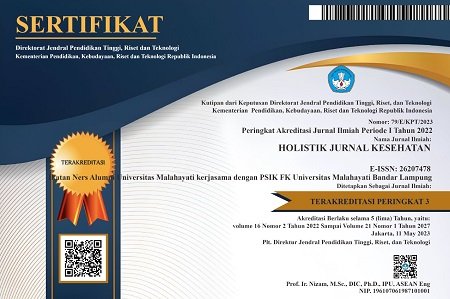PENYEBARAN VIRUS DENGUE SECARA TRANSOVARIAL PADA VEKTOR DEMAM BERDARAH DENGUE NYAMUK Aedes aegypti
Abstract
TRANSOVARIAL TRANSMISSION OF DENV IN AEDES AEGYPTI
Background: Transovarial transmission of dengue virus in Aedes aegypti mosquitoes is a vertical transmission of dengue virus infection in female Ae. aegypti mosquitoes to the offspring. The phenomenon of transovarial dengue virus transmission in Dengue Hemorrhagic Fever (DHF) vectors has been proven by laboratory and nature, which indicates the transovarial transmission of dengue virus has an important role in maintaining the dengue epidemic. DHF vector control especially Ae. aegypti mosquitoes is an effective method of stopping transmission and expansion of dengue cases.
Purpose: This scientific article aims to understand the spread of dengue virus transovarially in dengue mosquito vectors, and its relation to the prediction of outbreak dengue cases as information on DHF vector surveillance so that it can make the appropriate control program.
Methods: Collecting several scientific articles to obtain information on the studies that have been done and summarizing the results of the study.
Results: Several result of study are proving that transovarial transmission of dengue virus in Aedes spp. mosquitoes can predict dengue outbreaks case by monitoring the stadium immature Aedes sp., but it need further comprehension statistically about occurrence of dengue outbreaks and the increasing of dengue virus infections in immature stadium of mosquitoes.
Discussion: Transovarial transmission rates from Ae. aegypti mosquito sample obtained from nature may be lower than in the laboratory, because laboratory condition can be controlled in accordande with the development of viruses in mosquito bodies. The dengue virus is proven to be able to spread between stages from eggs, larvae, pupae to imago and Ae. aegypti mosquitoes can act as reservoirs for dengue virus until the 7th progeni.
Conclusion: Dispersion dengue virus through transovarial in Ae. aegypti mosquito playing important role in viruses maintained in nature during absence of viremic vertebrata host or when the climate condition are not favorable for that viruses. Continuous monitoring of Ae. aegypti mosquitoes population vector related the early detection of virus circulation may contribute to the prediction models for dengue outbreaks, so that DHF control can be more effective.
Pendahuluan: Penularan virus dengue secara transovarial pada nyamuk Aedes aegypti adalah transmisi secara vertikal dari nyamuk Ae. aegypti betina yang infektif virus dengue kepada keturunannya. Fenomena penularan transovarial virus dengue pada vektor Demam Berdarah Dengue (DBD) telah banyak dibuktikan skala laboratorium dan secara natural di alam, yang mengindikasikan penularan transovarial virus dengue memiliki peranan penting dalam mempertahankan epidemik DBD. Pengendalian vektor DBD khususnya nyamuk Ae. aegypti merupakan salah satu metode efektif dalam menghentikan penularan dan perluasan kasus DBD.
Tujuan: Studi ini untuk memahami penyebaran virus dengue secara transovarial pada vektor nyamuk DBD, serta kaitannya terhadap prediksi kasus luar biasa (KLB) DBD sebagai informasi surveilans vektor DBD sehingga dapat membuat program pengendalian yang tepat.
Metode: Dengan mengumpulkan beberapa artikel ilmiah untuk mendapatkan informasi studi yang telah dilakukan sebelumnya dan membuat ringkasan dari hasil studi tersebut.
Hasil: Beberapa studi membuktikan penelitian transovarial virus dengue pada nyamuk Aedes spp. dapat memprediksi kasus KLB DBD dengan cara memonitoring stadium immature Aedes sp., namun perlu dilakukan studi statistik lebih lanjut untuk membuktikan hubungan terjadinya KLB DBD dan meningkatnya infeksi virus dengue pada stadium immature nyamuk.
Pembahasan: Angka infeksi penularan transovarial virus dengue dari sampel nyamuk Ae. aegypti yang didapatkan langsung dari alam lebih rendah dari skala laboratorium, dikarenakan kondisi laboratorium dapat dikendalikan sesuai dengan perkembangan virus ditubuh nyamuk. Virus dengue terbukti dapat menyebar antar stadium dari telur, larva, pupa, sampai imago dan nyamuk Ae. aegypti dapat menjadi reservoir virus dengue sampai progeni ke 7.
Kesimpulan: Penyebaran virus dengue secara transovarial pada nyamuk Ae. aegypti berperan penting dalam mempertahankan keberadaan virus di alam khususnya dimana tidak ada hospes vertebrata yang viremik atau ketika keadaan (kondisi iklim) yang tidak menguntungkan virus tersebut di alam. Pemantauan berkelanjutan pada vektor demam berdarah nyamuk Ae. aegypti terkait deteksi dini sirkulasi virus dengue dapat berkontribusi pada pengembangan model prediksi KLB DBD, sehingga pengendalian DBD dapat lebih efektif.
Keywords
References
Andriyoko, B., Parwati, I., Tjandrawati, A., & Lismayanti, L. (2012). Penentuan serotipe virus dengue dan gambaran manifestasi klinis serta hematologi rutin pada infeksi virus dengue. Majalah Kedokteran Bandung, 44(4), 253-260.
Arunachalam, N., Tewari, S. C., Thenmozhi, V., Rajendran, R., Paramasivan, R., Manavalan, R., ... & Tyagi, B. K. (2008). Natural vertical transmission of dengue viruses by Aedes aegypti in Chennai, Tamil Nadu, India. Indian Journal of Medical Research, 127(4), 395.
Cucunawangsih, & Lugito, N. P. H. (2017). Trends of dengue disease epidemiology. Virology: research and treatment, 8, 1178122X17695836.
Grunnill, M., & Boots, M. (2015). How important is vertical transmission of dengue viruses by mosquitoes (Diptera: Culicidae)?. Journal of medical entomology, 53(1), 1-19.
Günther, J., Martínez-Muñoz, J. P., Pérez-Ishiwara, D. G., & Salas-Benito, J. (2007). Evidence of vertical transmission of dengue virus in two endemic localities in the state of Oaxaca, Mexico. Intervirology, 50(5), 347-352.
Joshi, V., & Sharma, R. C. (2001).Impact of Vertically-Transmitted Dengue Virus on Viability of Eggs of Virus-Inoculated Aedes aegypti.
Joshi, V., Mourya, D. T., & Sharma, R. C. (2002). Persistence of dengue-3 virus through transovarial transmission passage in successive generations of Aedes aegypti mosquitoes. The American journal of tropical medicine and hygiene, 67(2), 158-161.
Joshi, V., Singhi, M., & Chaudhary, R. C. (1996). Transovarial transmission of dengue 3 virus by Aedes aegypti. Transactions of the Royal Society of Tropical Medicine and Hygiene, 90(6), 643-644.
Khin, M. M., & Than, K. A. (1983). Transovarial transmission of dengue 2 virus by Aedes aegypti in nature. The American journal of tropical medicine and hygiene, 32(3), 590-594.
Kow, C. Y., Koon, L. L., & Yin, P. F. (2001). Detection of dengue viruses in field caught male Aedes aegypti and Aedes albopictus (Diptera: Culicidae) in Singapore by type-specific PCR. Journal of medical entomology, 38(4), 475-479.
Lee, H. L., & Rohani, A. (2005). Transovarial transmission of dengue virus in Aedes aegypti and Aedes albopictus in relation to dengue outbreak in an urban area in Malaysia.
Martínez, N. E., Dzul-Manzanilla, F., Gutiérrez-Castro, C., Ibarra-López, J., Bibiano-Marín, W., López-Damián, L., ... & Manrique-Saide, P. (2014). Natural vertical transmission of dengue-1 virus in Aedes aegypti populations in Acapulco, Mexico. Journal of the American Mosquito Control Association, 30(2), 143-146.
Martins, V. E. P., Alencar, C. H., Kamimura, M. T., de Carvalho Araujo, F. M., De Simone, S. G., Dutra, R. F., & Guedes, M. I. F. (2012). Occurrence of natural vertical transmission of dengue-2 and dengue-3 viruses in Aedes aegypti and Aedes albopictus in Fortaleza, Ceará, Brazil. PloS one, 7(7), e41386.
Rohani, A., Zamree, I., Joseph, R. T., & Lee, H. L. (2008). Persistency of transovarial dengue virus in Aedes aegypti (Linn.). Southeast Asian J Trop Med Public Health, 39(5), 813-816.
Rohani, A., Zamree, I., Lee, H. L., Mustafakamal, I., Norjaiza, M. J., & Kamilan, D. (2007). Detection of transovarial dengue virus from field-caught Aedes aegypti and Ae. albopictus larvae using C.
Seran, M. D. (2010). Uji laboratorium penularan trans-stadial virus dengue pada stadium telur, larva, pupa dan imago dari nyamuk aedes aegypti (Diptera Culicidae) (Master's thesis, Universitas Gadjah Mada).
Thavara, U., Siriyasatien, P., Tawatsin, A., Asavadachanukorn, P., Anantapreecha, S., Wongwanich, R., & Mulla, M. S. (2006). Double infection of heteroserotypes of dengue viruses in field populations of Aedes aegypti and Aedes albopictus (Diptera: Culicidae) and serological features of dengue viruses found in patients in southern Thailand. Southeast Asian journal of tropical medicine and public health, 37(3), 468.
Thenmozhi, V., Hiriyan, J. G., Tewari, S. C., Samuel, P. P., Paramasivan, R., Rajendran, R., ... & Tyagi, B. K. (2007). Natural vertical transmission of dengue virus in Aedes albopictus (Diptera: Culicidae) in Kerala, a southern Indian state. Japanese journal of infectious diseases, 60(5), 245.
Thenmozhi, V., Tewari, S. C., Manavalan, R., Balasubramanian, A., & Gajanana, A. (2000). Natural vertical transmission of dengue viruses in Aedes aegypt in southern India. Transactions of the Royal Society of Tropical Medicine and Hygiene, 94(5), 507.
Thongrungkiat, S., Maneekan, P., Wasinpiyamongkol, L., & Prummongkol, S. (2011). Prospective field study of transovarial dengue‐virus transmission by two different forms of Aedes aegypti in an urban area of Bangkok, Thailand. Journal of Vector Ecology, 36(1), 147-152.
Umniyati, S.R. (2004). Preliminary Investigation on The Transovarial Transmission of Dengue Virus in The Populatian of Ae. aegypti in the Well. Makalah disajikan dalam Seminar Peringatan Hari Nyamuk IV. Surabaya.
Vilela, A. P., Figueiredo, L. B., dos Santos, J. R., Eiras, Á. E., Bonjardim, C. A., Ferreira, P. C., & Kroon, E. G. (2010). Dengue virus 3 genotype I in Aedes aegypti mosquitoes and eggs, Brazil, 2005–2006. Emerging infectious diseases, 16(6), 989.
Wasinpiyamongkol, L., Thongrungkiat, S., Jirakanjanakit, N., & Apiwathnasorn, C. (2003). Susceptibility and transovarial transmission of dengue virus in Aedes aegypti: a preliminary study of morphological variations. Southeast Asian journal of tropical medicine and public health, 34, 131-135.
World Health Organization. (2009). Special Programme for Research, Training in Tropical Diseases, World Health Organization. Department of Control of Neglected Tropical Diseases, World Health Organization. Epidemic, & Pandemic Alert. (2009). Dengue: guidelines for diagnosis, treatment, prevention and control.
World Health Organization. (2011). Comprehensive guideline for prevention and control of dengue and den
DOI: https://doi.org/10.33024/hjk.v12i4.81
Refbacks
- There are currently no refbacks.
Copyright (c) 2019

This work is licensed under a Creative Commons Attribution-NonCommercial 4.0 International License.














